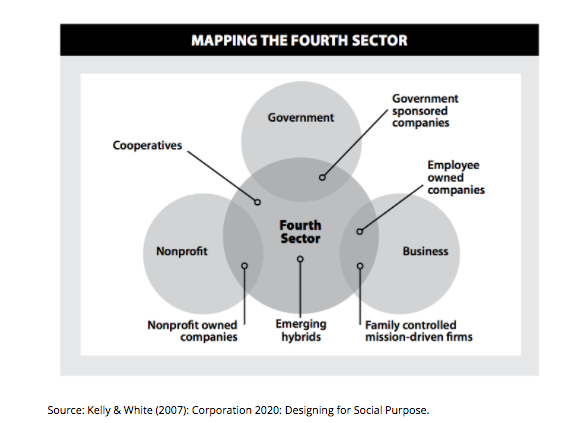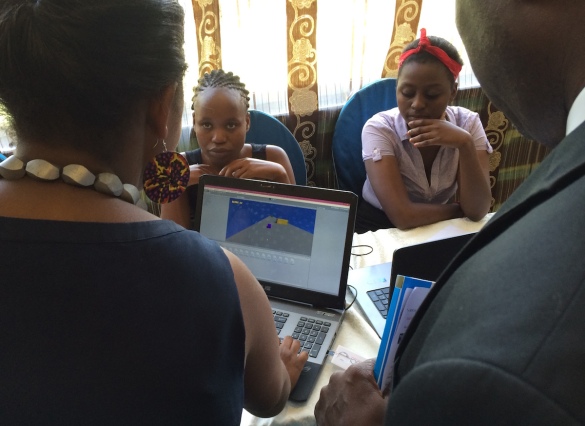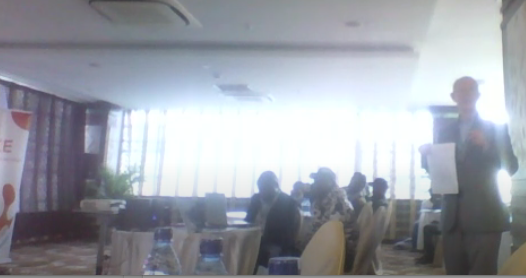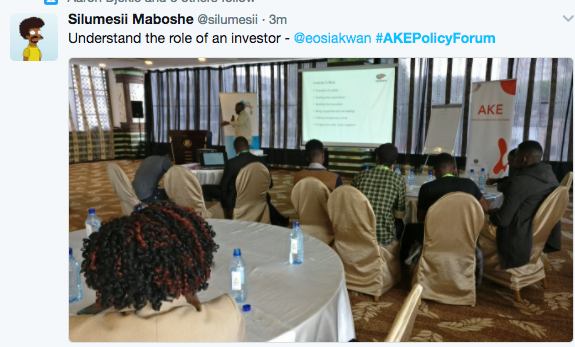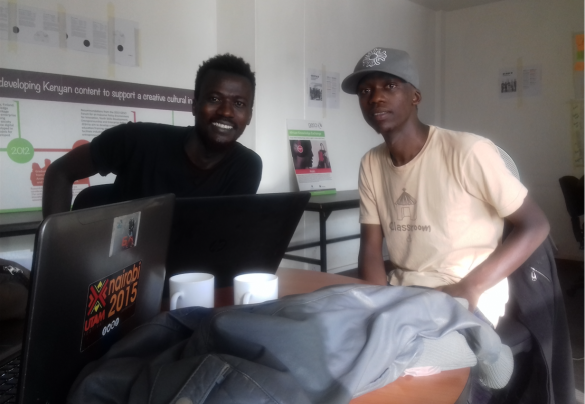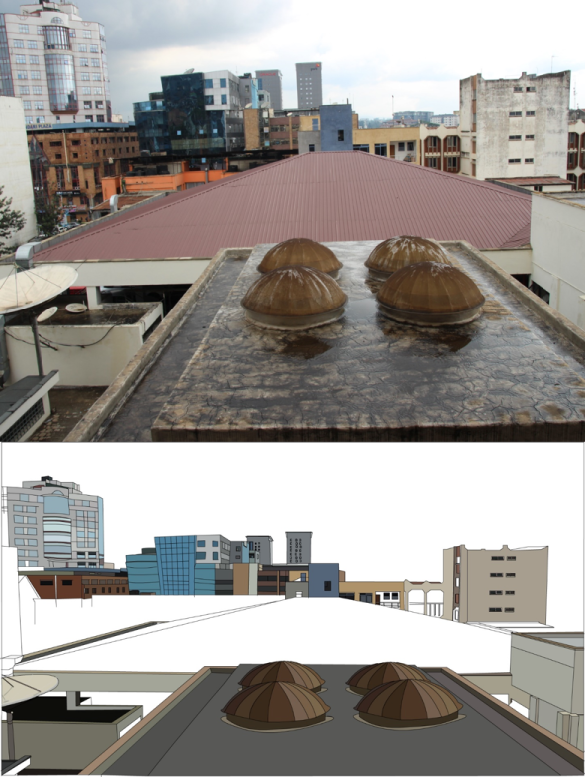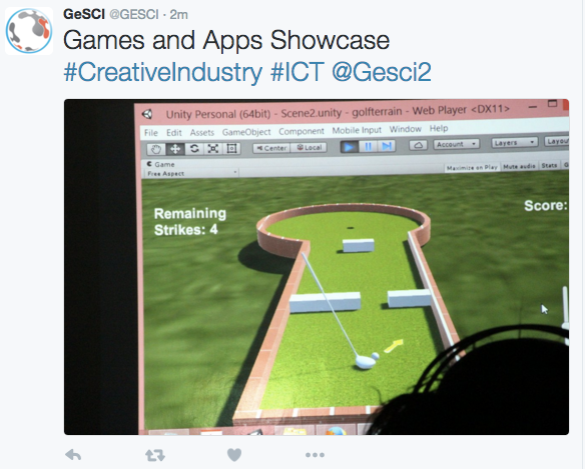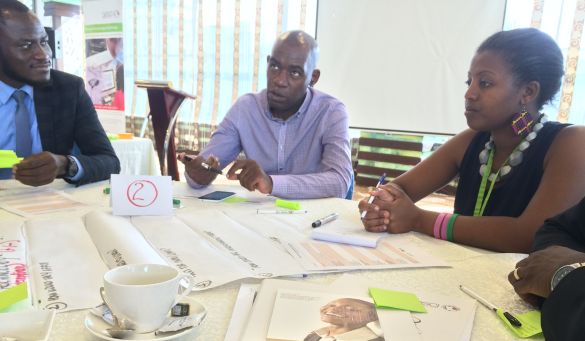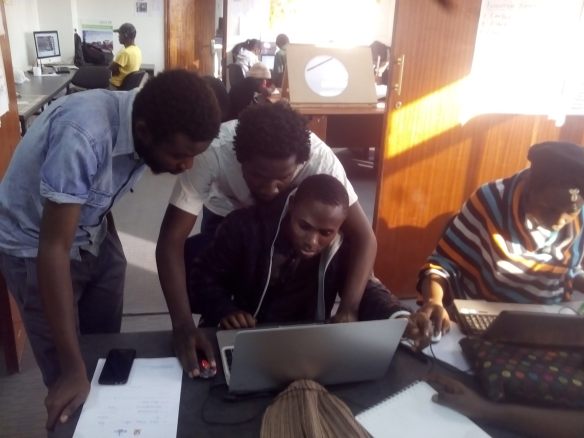Context
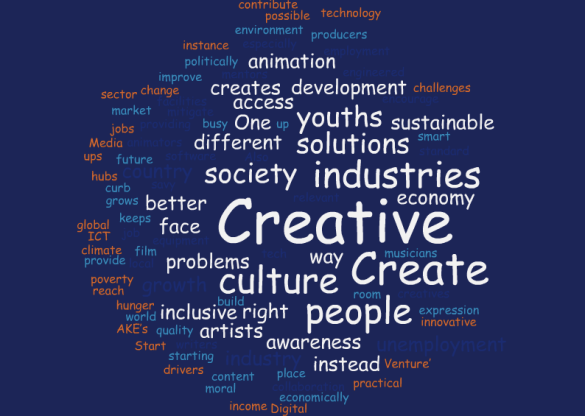
GESCI-AKE participants: Word cloud on their thoughts on entrepreneurship and development.
GESCI is pioneering an innovative training and enterprise program model combining culture and digital media technology dubbed ‘African Knowledge Exchange (AKE) – Creative Media Venture’.
(…)
The program addresses the changing global jobs and employment environment driven by new technologies in the context of growing youth unemployment.
- Jerome Morrissey, GESCI CEO
This post is based on the GESCI-AKE projects: The Sound of the City (2014-2015), and GESCI-AKE Creative Media Venture (2016-2017). Both have been rooted in the ongoing, urgent, and increasingly global, concern of sustainable future of work for the world’s youth.
GESCI-AKE’s training and enterprise model is in line with the trend that believes in local entrepreneurship as one of the most empowering, and cost-effective, solutions local systemic problems of youth employment. Compared to 14 major, established innovation and training labs/hubs in Eastern and Southern Africa, GESCI’s approach has been unique in three ways:
- It has captured participants who are motivated and already working on their art and creative digital media endeavors, but who need more concrete skills, elevated understanding of the field, as well as tools to become independent entrepreneurs in the field of creative industries;
- It has focused on local culture as a competitive edge (while bringing in international influence and tutors); and
- It has allowed for multi-field training and innovation.
GESCI-AKE programs have from the start combined two aspects: understanding the marketplace but listening to the individual, for bringing big concepts into the practical pedagogy and training.
The programs have sought to capture the processes of learning and innovation in the day-to-day, micro-level of the training and entrepreneurial incubation. This has been done through a method of Living Lab. Solution-oriented, participatory models such as Living Lab have become common in product innovations, but also in curriculum development, policy-making, communication campaigning, and international development.
The GESCI-AKE program has been using the method since 2014. The research, conducted by questionnaires, interviews, and formal and informal observations and participation by practitioners, instructors, and industry representatives, has studied both content and needs of both the participants and the industry, as well as documented the implementation and modeling of such training.
You can find the concrete process and progress of the Living Lab in this blog.
The Living Lab research (2016-17) has also transferred the actual training-incubation process into a model that can be used for skills-entrepreneurship training in fields of creative products and services. Details of the model, and related best practices and tools, are documented in an extensive Final Model Report.
This post documents the key findings regarding youth entrepreneurship, as documented in detail in a separate Policy Brief. (Both documents will be available from GESCI at the end of March 2017.)
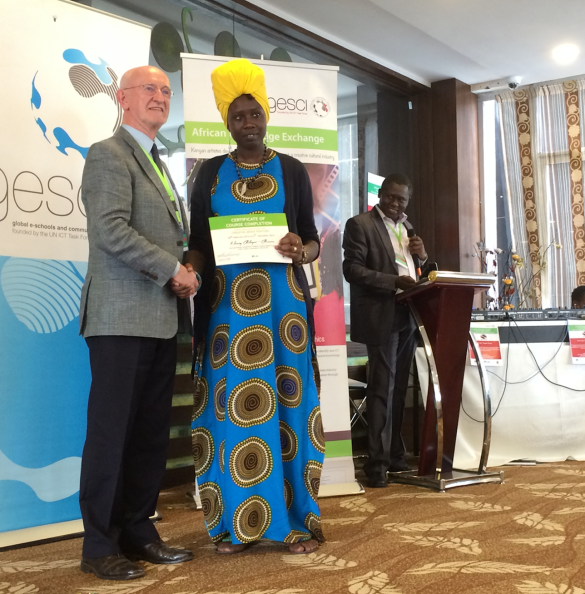
Jerome Morrissey congratulating AKE graduates.
Thesis #1: No One Solution, Or, Context Matters
While the 7 theses from GESCI-AKE are quite generalizable, the first lesson learned is that a successful training and start-up incubation needs to understand the specific marketplace first. There is no one solution, or model.
As noted, the GESCI-AKE approach to innovation in youth entrepreneurship is twofold – markets and individuals – and understanding one’s context is thus the foundation of success. This may seem self-evident, but in the rapidly-changing digital landscape and globalizing markets, coupled with local conditions, this means constant analysis of societal and market needs. A commonly used method is the strategic planning tool, SWOT analysis: Strengths, Weaknesses (existing situation), Opportunities, and Threats (future scenario). As an example, a recent SWOT on East African Creative Industries posits the following:
Strengths:
- Rapid growth of especially mobile communications means rapidly growing market.
- Cultural distinctiveness, very strong traditions, and real flair across creative sectors including music, crafts, fashion, visual arts, film, define the centrality for creative industries for the economy in the region. rapid urbanisation re-creates cities as centers for talent and creativity.
- Digitalization resulting in proliferation of straight-to-digital business models across the region.
- Digitalization fostering a culture of collaboration across different sectors, disciplines and technologies.
- A sense of an emergent new world order and growing confidence in African creative industries marks the field.
Weaknesses:
- Some cultural conservatism = an aversion to risk.
- Weak creative education.
- Low levels of entrepreneurialism, management and leadership (education needed).
- Growing (digital) literacy across the wider population is needed to unleash the market potential.
- Tendency of replication over innovation.
- Lack of policy support in the field of education + inconsistent approaches to copyright.
Opportunities to take (Threats =if opportunities not taken):
- Build capacity and confidence across the creative workforce.
- Create digitally-enabled platforms which showcase and trade creative goods and services.
- Nurture domestic and international markets for creative products and services. Even small growth creates many jobs.
- Establish a set of high profile networks of creative industries for information exchange.
- Position the creative industries as value-adders across the economy in order to lift the quality and innovation potential of other sectors.
- Improve the policy and regulatory landscape through capacity-building and guidance.
Such a macro-level analysis as the above has understandably direct consequences on the organizational foci for training. For instance, GESCI has recognized the need for education in the field, including demands for entrepreneurial skills and “confidence-building”; the need for networks; the role of creative industries as collaborating and supporting other industries, and so on.

Thesis #2: Entrepreneurship Cannot Be Cloned. Education Must Be Flexible
The second thesis pertains to flexibility required of innovation and training models of youth entrepreneurship. The demand for flexibility comes from both opportunities in the changing markets and technology, as well as from the individual participants. In other words, entrepreneurship cannot be cloned. This requirement influences curriculum as well as product/innovation development, ways of learning and working; as well as the entire outlook of what is being learned and developed beyond the obvious practical skills.
It is also good to remember that not everyone is entrepreneurial. The flexibility of any training or support mechanism should allow some participants, who may need more skills and experience, or who might discover that they are not entrepreneurial enough to launch their own startup, still get relevant training that will lead to meaningful job opportunities in the industry.
Another aspect of flexibility is that innovation may require a broad talent and skill-set — and staying relevant as an entrepreneur may mean encompassing several fields. This is obvious to GESCI-AKE participants: They defined themselves often along a continuum that included several areas (“I am not only a musician, but musician- sound designer -producer”). In addition, entrepreneurship requires more than skills and innovation. Participants have been encouraged to think about their skills and learning more holistically, by not only developing practical skills but rather “an attitude to our work, and ourselves”.

Thesis #3: Everything is Entrepreneurial
The third thesis is closely connected to the second, but warrants its own discussion. While it may seem that micro and small-sized enterprises (the kinds of startups that young people are likely to have) can easily run and market themselves due to their size, knowing business skills to do so is not a given — quite the contrary. Beyond specific issues such as accounting and copyright, there are basic business practices and principles that need fostering.
UNIDO research on start-ups shows that the biggest challenge in continuity seems to come after the initial incubation and first projects, when first hardships are faced (financial or other challenges). This requires strong leadership skills, confidence, and self-reliance — traits that can be practiced. At the same time, one of the main causes of failure is that there is no market for the product offered, and because their business model was not viable. This points to the urgent need for innovations and youth entrepreneurs to understand their market and be able to systematically plan their revenue sources.
GESCI-AKE model curriculum for developing entrepreneurial competences relies on a behavioral approach to entrepreneurship. This is a practical approach that help participants develop Personal Entrepreneurial Competencies (PEC) while doing, as opposed to attending lectures. The GESCI-AKE model works to develop the following attitudes: Opportunity-seeking behavior, Taking calculated risks, Persistence, Demand for efficiency and quality, Fulfilling commitments, Information seeking, Goal-setting and Self-confidence.
In addition, the rise of social entrepreneurship and social innovation as a business model may be a very attractive alternative for young entrepreneurs in creative medial. There is clearly a political trend to favor and support activities, big or small, that position themselves as innovators of social value.

Mary Hooker of GESCI facilitating a brainstorming workshop.
Thesis #4. Physical Space Matters for Innovation
In entrepreneurial training, online tools and platforms are widely used. Even the location-based GESCI-AKE utilized this blog, informal email lists, Dropbox folders, Google Drive folders, Youtube channel, Facebook page, Whatsapp groups, Trello boards, Slack channel, and two Twitter accounts. Many of these tools are attractive as they are open access, and also widely used in professional contexts. Getting familiar with them is important.
Still, a strong thesis of the GESCI-AKE programs is that a physical space is essential for fostering youth entrepreneurship, especially among young people with limited resources and experience.
To be sure, a hub is a tested framework: The rise of numerous entrepreneurial education projects, start-up incubators, innovation centers, and the like, is evident in the region. East and South Africa are prominent hosts of such hubs. (In general, the number of technology hubs has doubled in Africa in less than a year, from 2015 to mid 2016.)
Also, as organizations, innovation hubs, programs, and training projects are creating value beyond their start-ups and products in multiple ways:
- Through building a network for “collaborative knowledge exchange and research activities”, innovation hubs can help their stakeholders solve problems that they have defined, increasing the opportunities of co-creation innovation.
- In order to maximize the benefits for those involved, innovation hubs should play a role in accelerating the communication between academia and industries and encourage highly interactive “two way knowledge exchange”.
- By offering an environment to enhance the collaboration among people, innovation hubs would be able to support the economic, cultural and sustainable development for future generations.
- Innovation hubs can not only create communicating channels but also simplify the process of innovation by efficiently adopting existing knowledge, expertise and support from various stakeholders in order to make knowledge transfer spread widely.
Thesis #5: Find a Niche
The fifth thesis on fostering innovation in youth entrepreneurship is: Find a niche. As illustrated in Thesis 4., ICT innovation hubs are multiplying and related activities seem to be considered as priority. But innovation that can utilize digital tools is happening in every field. Supporting an under-supported field, or group may be most effective and important than replicating an existing innovation model. For GESCI-AKE, this niche has been local culture and cultural competence:

Thesis #6: No Success Without Collaboration
The sixth thesis seems self-evident in theory but is a challenge in practice: How to create mechanisms of collaboration and knowledge exchange so that youth entrepreneurship innovation is reflecting, and contributing to, the needs of the relevant stakeholders? Vice versa: how can stakeholders help in guaranteeing the success of young entrepreneurs?
The GESCI-AKE programs, and the emerging model, rely on supporting a collaborative continuum approach that includes simple and complex forms of partnership. These relationships are created with-in, with the hosting organization (e.g. GESCI) and with external partners (community, industry, educational representatives, etc) via mentoring and networking partnerships and through follow up actions. As the figure below illustrates (with the case of GESCI), the network of stakeholder can be a surprisingly complex one, and every stakeholder needs to feel a certain ownership/connection to the project and benefit from it in order to commit.

Some concrete ways to enhance collaboration include:
- Policy forums and networking events for knowledge exchange and innovation
- Lectures, issue roundtables
- Site visits
- Industry mentors
- Internships
- Commissioned projects as a part of the curriculum
- Pitching / project evaluation / showcases
- Community outreach and events
- Stakeholders involved in participant selection
- Job fairs

Pitching to an industry partner.
Thesis #7: Support Should Continue “Forever”
Entrepreneurship is a life-long journey and learning experience. Especially young entrepreneurs need support, not only training.
As noted by UNIDO, based on its start-up programmes in the Global South: Ideas are plentiful but the absence of actual technical and business development support often stops innovative projects and startups after their initial seed funding ends. Research shows that not only is the lack of education or seed funding a challenge, but societal attitudes, and support services were found to be barriers for youth entrepreneurship in Africa.
This raises a question as to what role should an innovation-training model-hub play. Is training and short incubation enough of a competitive edge? Or, is such a hub a meeting place for alumni, a pitching and networking, center, a facility for continuing education, even employment agency or match-maker, a community center, and so on?
These are questions that GESCI-AKE is only now experimenting with, given that is its currently finalizing the training of the first incubation-start-up cohort. Activities and strategies are placed to follow up on the trajectories of all those involved in any GESCI-AKE cohort. This facilitates transitions of roles: For instance, previous participants to become mentors or tutors, mentors that might become investors, attendants to an event to become partners (by commissioning work), and so on.
The strong consensus among GESCI-AKE staff and participants is that continuing support has several benefits:
- Networking for jobs, contacts, and skills.
- Alumni can utilize the technology if in need.
- GESCI-AKE as a brand that provides peer-to-peer marketing for its participants and alumni, and vice versa.
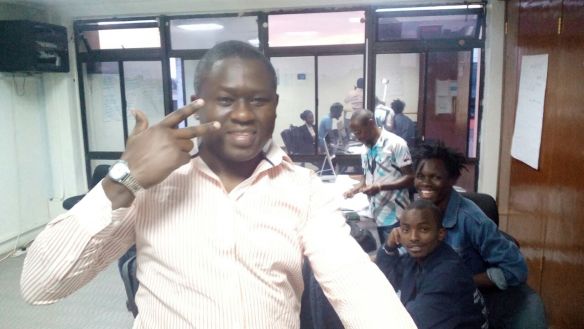
Continuous support by Victor Omondi, GESCI-AKE manager.


